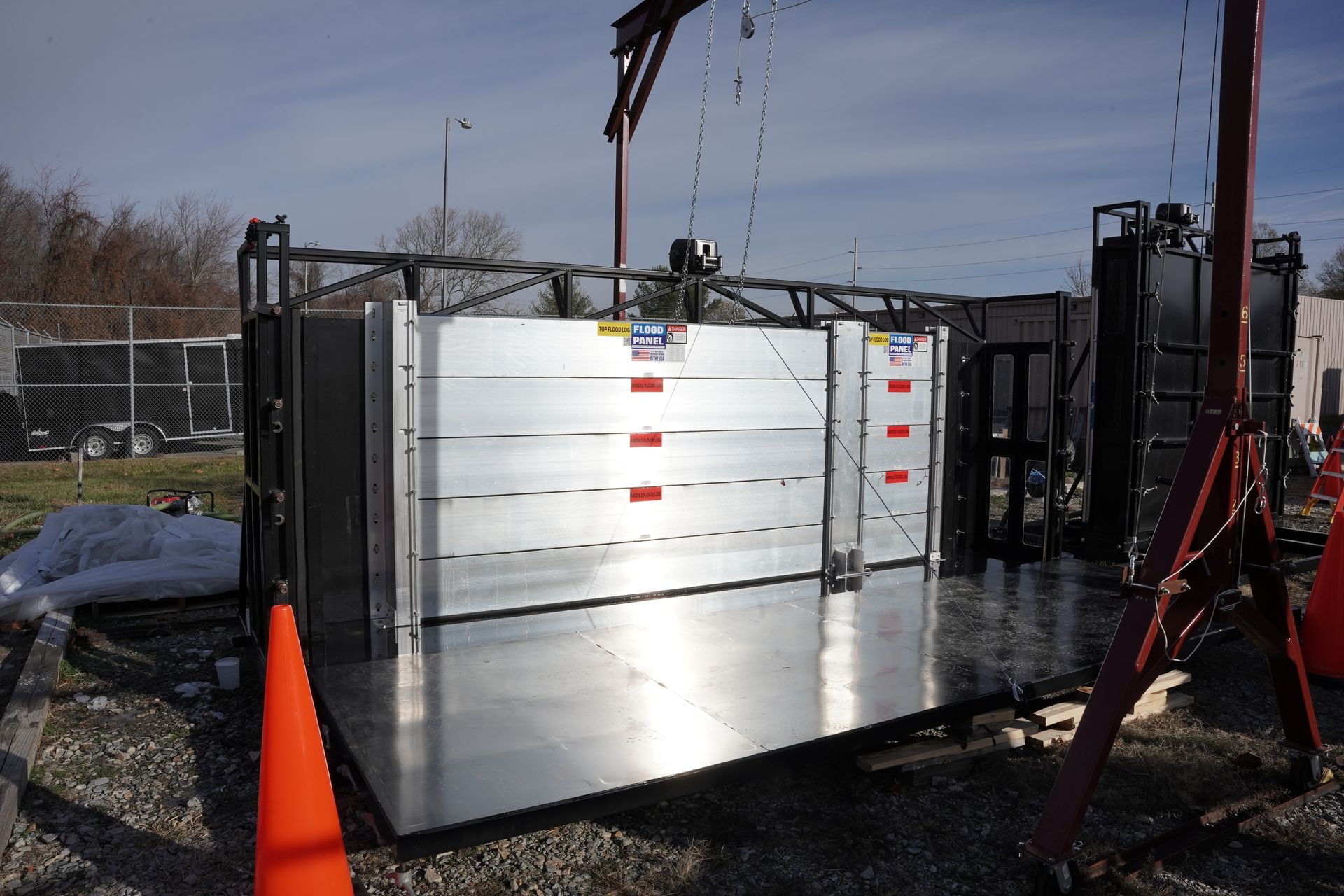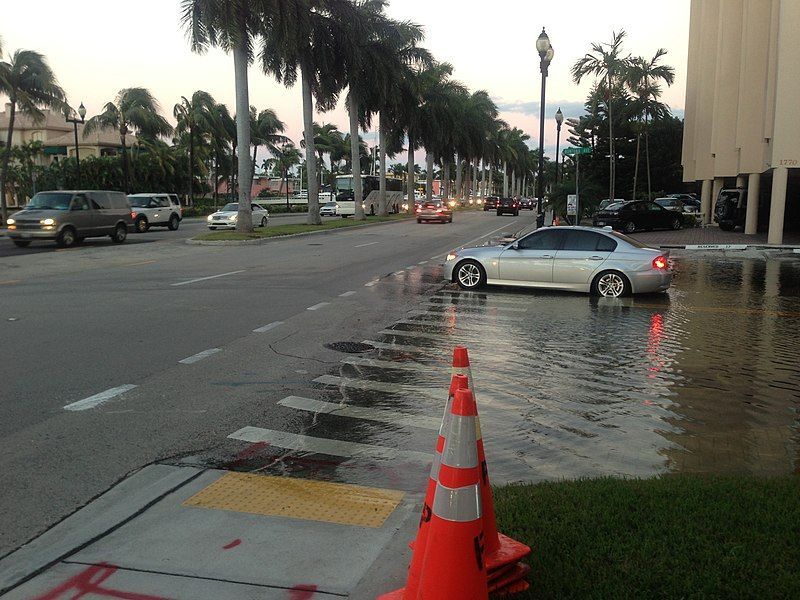Page 24
Media Contact
Email: media@floodpanel.com
South Carolina Floods Disable the State
During the first week of October, a freakish storm system battered the southeastern U.S. states, particularly South Carolina. Hurricane Joaquin, which did not directly hit the region, nevertheless contributed massive amounts of precipitation to other smaller storms and then collided with a cold front that had stalled in the area. In what is being called a 1000-year event, record-smashing amounts of rain battered an entire state to a standstill. In fact, some meteorologists are predicting that this storm system, when all precipitation meters are recorded, will be revealed as the most prolific storm in the recorded history of the U.S. … ever! When the rain finally let up after a five-day torrent, 25 people had lost their lives.
A levee breach at the Columbia Riverfront Canal, Columbia, S.C., during a statewide flood Oct. 5, 2015. The South Carolina National Guard has been activated to support state and county emergency management agencies and local first responders as historic flooding impacts counties statewide. Currently, more than 1,100 South Carolina National Guard members have been activated in response to the floods. (U.S. Air National Guard photo by Tech. Sgt. Jorge Intriago/Released)
Several weeks after the storm, the state of South Carolina has yet to fully recover. It is thought that it will take months to fully assess the damage to area dams and bridges, as multiple rivers burst their banks during the storm, causing devastating damage downstream. At least 18 dams were breached during the flooding, and many of these collapsed completely. Some bridges and dams that remain standing may have hidden damage or flaws that could become very dangerous during the next storm if not discovered before then. Engineers are working hard to inspect all the dams and bridges that survived the storm, even as plans to rebuild collapsed flood barriers are being prepared. In addition to the destroyed dams and bridges, many roads, including major thoroughfares, remained unsafe and impassable several weeks after the storm. A 75-mile section of I-95, the main interstate passing through the state, was closed during and after the storm, causing extreme havoc to interstate transport and commuters.
Another serious after-effect of the storm was contamination to the water supply. People were urged to thoroughly boil any water used for drinking or cooking, and to discard any ice that had been made from water after the storm. The flooding in South Carolina was so extreme, and so widespread, that the contaminated floodwaters had mixed with reservoir water, cisterns, and other water collection systems, rendering the public water supply unsafe. FEMA disaster relief funding will be available for flood survivors who sustained losses in this storm. Funds may be used to pay for temporary rentals or home repairs. For example, many homes that withstood the floods are now uninhabitable due to mold and mildew
The storm of October 2015, although not a named hurricane, will live a long time in the memories of all those who endured that five days of anxiety, fear, and an almost total disruption of daily life. In some parts of South Carolina, almost two feet of rain was gauged during the five days of unrelenting downpour, smashing records for daily, weekly, and even monthly rainfall levels — all from one epic storm. Many towns were entirely submerged, and the devastation was so widespread that almost no part of the state emerged unscathed. Although the storm is being called a ‘1000-year flood’, it is very likely that the next 1000-year flood will arrive considerably sooner than 1000 years from now.
Source:: FloodBarrierUSA
Flash floods are among the most deadly of all the flooding scenarios, because victims simply do not have enough time to get out of harm’s way. Every year, flash floods occur in the arid U.S. Southwest, and unfortunately, lives are often lost as a result. 2015 was a particularly bad year for flash flooding in the state of Utah. Freak twin storm events in September produced 2″ of rain in a very short period of time, which quickly filled creeks, canyons, and gullies. The storm has been described as a 100-year event, and the resulting loss of life was devastating. When it was over, the storm had earned a place in the record books as the deadliest storm in Utah’s history, with at least 20 lives lost.
USGS scientist Brad Slaugh taking measurements following a flash flood event in Hildale, Utah. Photo taken 9/15/2015 by Jake Benson/USGS
The storm began as Hurricane Linda, but it was quickly downgraded from hurricane status as it moved into the U.S. Southwest. As it entered the arid states of Utah and Arizona, the storm dumped most of the precipitation that it had picked up in the tropics. Because the ground was rock-hard from a persistent drought, the water immediately ran off and quickly produced life-threatening conditions. At this point, the National Weather Service released its most strongly worded warning: “Move to higher ground now. Act quickly to save your life!”
Unfortunately, a number of people gathered near Short Creek to watch the rapidly rising water level. Sixteen of these bystanders were carried off by the rushing water as it suddenly rose and swept away two vehicles. This disaster resulted in the deaths of 13 people, but three children were miraculously rescued by emergency personnel. Hundreds of rescue workers and volunteers braved hazardous conditions to search for one missing child, but the river was so dangerous that their work was greatly impeded.
Another crisis occurred at Zion National Park when an inordinate amount of precipitation caused flash flooding in the Keyhole Canyon area. This popular hiking area is characterized by slot canyons- these are very narrow canyons with steep sides that allow no chance of escape when floods strike. These canyons are close to the Virgin River, and when this river rises quickly, the slot canyons can become death traps. During the sudden storms on this day, the Virgin River rose from its normal volume levels of 55 ft3 per second to 2,630 ft3 per second… in under 15 minutes.
Rangers quickly moved to close all the canyon hiking areas, but one group of seven people had decided to go ahead with the hike in spite of unfavorable weather forecasts. Trapped in the slot canyons when they filled with ferocious torrents of water, all seven hikers perished. Heroic rescue workers faced extremely dangerous conditions in an effort to locate the hikers, but to no avail.
The combined death toll of these storms was 20 individuals; 20 lives were cut short, and many other lives were scarred by sorrow and loss as a result. The lesson learned by survivors is stark: flash floods are so dangerous and so fast-moving, that the warning of the National Weather Service must be heeded immediately: move to higher ground, and act FAST to save your life!
Source:: FloodBarrierUSA
Across North and South Carolina, communities are struggling after historic 1000-year flooding devastated parts of the region. It will be months, and possibly years, before many businesses impacted by the floods will be back in business. Some may never recover.
The National Flood Insurance Program reports that at least 25 percent of businesses that close after a flood don’t reopen.
Flood protection is the best defense against flood damage, and can provide businesses with some peace of mind in flood prone areas.
Hurricane Joaquin in the Atlantic Ocean north of Bermuda at 1315Z on October 5, 2015. GOES East satellite image from NOAA EVL.
In North and South Carolina, and in other places recently hit hard by flooding like Houston and the Jersey Shore, a number of forward-thinking businesses have taken steps to protect their assets with flood protection from Flood Panel LLC. (Click here for a list of Flood Panel projects.)
“We are heartbroken by the recent flood events in North and South Carolina, and our thoughts are with our many customers and business partners who live there,” said Tom Osborne, owner and president, Flood Panel. “The historic flooding demonstrates the unpredictability of storms, the catastrophic effect of flooding on communities, and the importance of being prepared for whatever Mother Nature brings.”
In regions at risk to major flooding, businesses have few options: move the building outside of the flood zone, elevate the structure above base flood elevation, build earthen barriers like berms, dikes and walls, or floodproof. Moving or elevating can add significant business hardship. According to the Army Corps of Engineers, floodproofing is the best choice, especially for urban structures.
Dry floodproofing requires that all large openings have flood barriers installed, areas below water level must resist infiltration, all small openings must be sealed, buoyancy effects should be considered and a method for pumping out leakage must be provided. Flood Panel’s expert consultancy and comprehensive line of flood panels, flood doors and custom flood solutions address any flood scenario.
The best flood defense is a good offense. A proactive approach to flood protection may spare businesses from catastrophic loss due to flooding caused by the next hurricane, historic rainfall or other extreme weather event.
For more information, visit www.floodpanel.com.
Source:: FloodBarrierUSA



